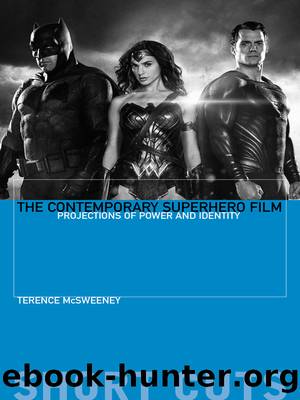The Contemporary Superhero Film by Terence McSweeney

Author:Terence McSweeney
Language: eng
Format: epub
Tags: PER004070, Performing Arts/Film/Genres/Action & Adventure, PER004140, Performing Arts/Film/Genres/Science Fiction & Fantasy
Publisher: Columbia University Press
Published: 2020-10-27T00:00:00+00:00
Fig. 4.1 Wesley Snipes as the eponymous lead in Blade (1998): a rare superhero film with a nonwhite actor as protagonist.
As already mentioned, the situation is considerably worse for representation of other ethnic groups, such as Asians, Hispanics, and Arabs, both in the superhero genre and in American film as a whole. Only 6.3 percent of characters in the top one hundred films of 2017 were Asian. Thirty-seven of these films had no Asian characters at all; twenty had no black characters; and forty-three had no Hispanics. The figures for women from racial minorities are even more depressing: forty-three had no black women; sixty-four had no Hispanic women; and sixty-five no Asian women. Furthermore, when Asian, Hispanic, or Arab characters do feature they tend to be marginalized or heavily stereotyped. Just as many comic book superheroes are black, many others are Asian like, including Amadeus Cho, Jubilee, Cassandra Cain (Batgirl), Silk, Kamala Khan (Ms. Marvel), and Xombi, but few of these will be familiar to general audiences as they have not been featured in films and there was not an Asian lead in a superhero film in the first two decades of the new millennium. The closest we get are supporting characters: Wong in Doctor Strange, Hogun in Thor, Jim Morita in Captain America: The First Avenger, Helen Cho in Avengers: Age of Ultron, Ned in Spider-Man Homecoming, or Mantis in Guardians of the Galaxy. This is evidence of Hollywoodâs ârocky history when it comes to its portrayals of Asian Americans, from the early yellow-face roles to the still-present examples of whitewashing,â which went largely uncommented on the mainstream media for decades but now at least is being discussed more frequently.5 When Asian cultures are featured in the genre, in films like Doctor Strange (2016) or television shows like Iron Fist (Netflix, 2017â18), they are seen exclusively through the eyes of a privileged Western male, who without exception prove themselves physically, intellectually, and morally superior to their Asian counterparts. The same issues affect the representations of Hispanic characters. Many exist in print, including Ghost Rider, White Tiger, Firebird, Miss America, and Blue Beetle, but very few of these find their way to the screens and if they do they are almost always portrayed by white, non-Hispanic actorsâin the case of Ghost Rider (2007) and Ghost Rider: Spirit of Vengeance (2012) they are cursedâ¦to be played by Nicolas Cage. A critical study conducted by Anhar Karim for Forbes in 2018 concluded that only 4 percent of the actors across the MCU are HispanicâBenicio Del Toroâs Collector and Maximiliano Hernándezâs Jasper Sitwellâand not a single major character is of Hispanic origin.6
Download
This site does not store any files on its server. We only index and link to content provided by other sites. Please contact the content providers to delete copyright contents if any and email us, we'll remove relevant links or contents immediately.
Call Me by Your Name by André Aciman(18964)
Ready Player One by Cline Ernest(12838)
How to Be a Bawse: A Guide to Conquering Life by Lilly Singh(6693)
Wiseguy by Nicholas Pileggi(4586)
The Kite Runner by Khaled Hosseini(4435)
On Writing A Memoir of the Craft by Stephen King(4213)
The Crown by Robert Lacey(4105)
Audition by Ryu Murakami(4099)
Call me by your name by Andre Aciman(4073)
Harry Potter and the Cursed Child: The Journey by Harry Potter Theatrical Productions(3964)
Gerald's Game by Stephen King(3918)
The Perils of Being Moderately Famous by Soha Ali Khan(3782)
Dialogue by Robert McKee(3582)
Dynamic Alignment Through Imagery by Eric Franklin(3489)
Apollo 8 by Jeffrey Kluger(3199)
How to be Champion: My Autobiography by Sarah Millican(3186)
Seriously... I'm Kidding by Ellen DeGeneres(3100)
Darker by E L James(3088)
History of Dance, 2E by Gayle Kassing(3000)
